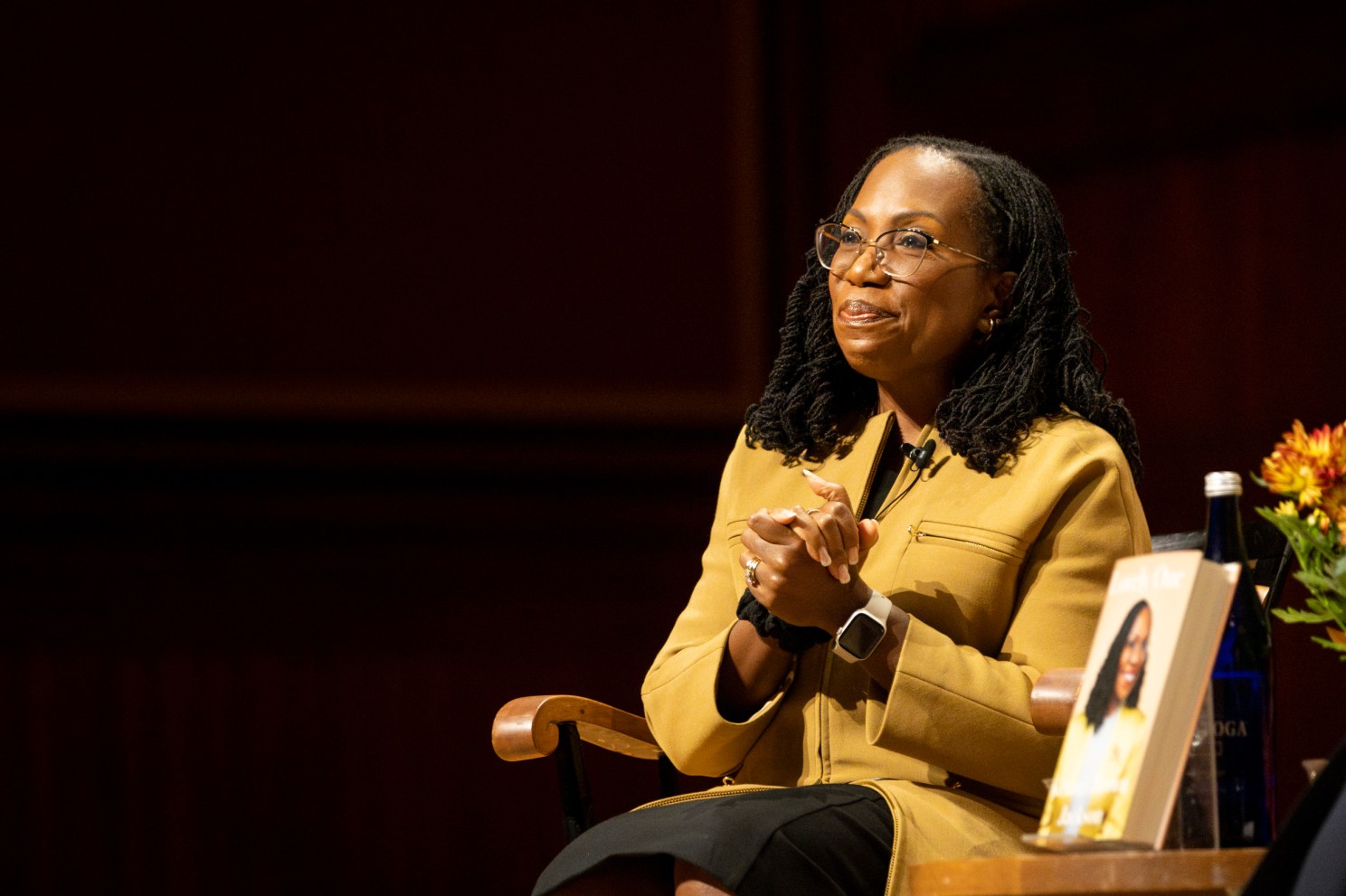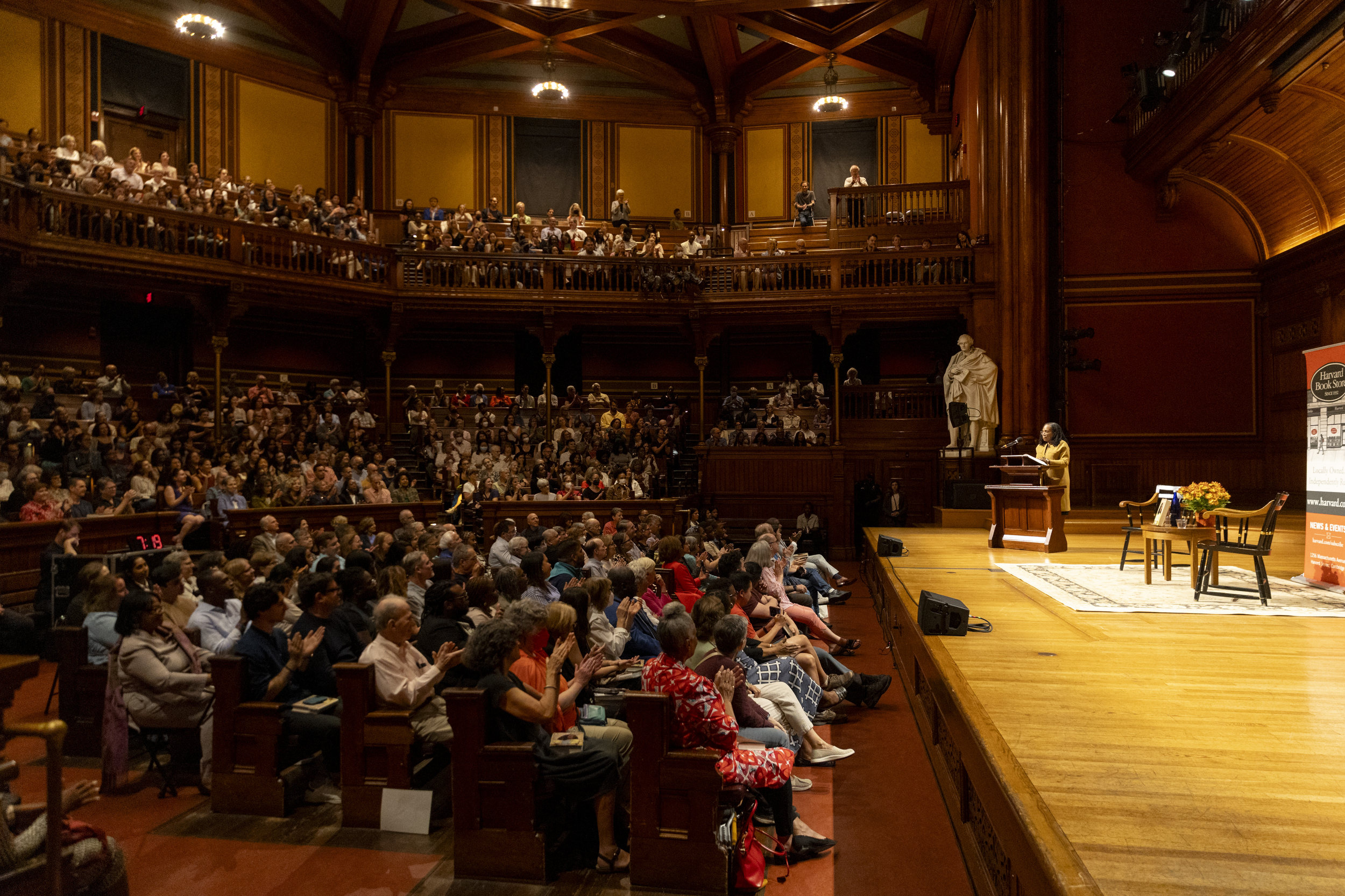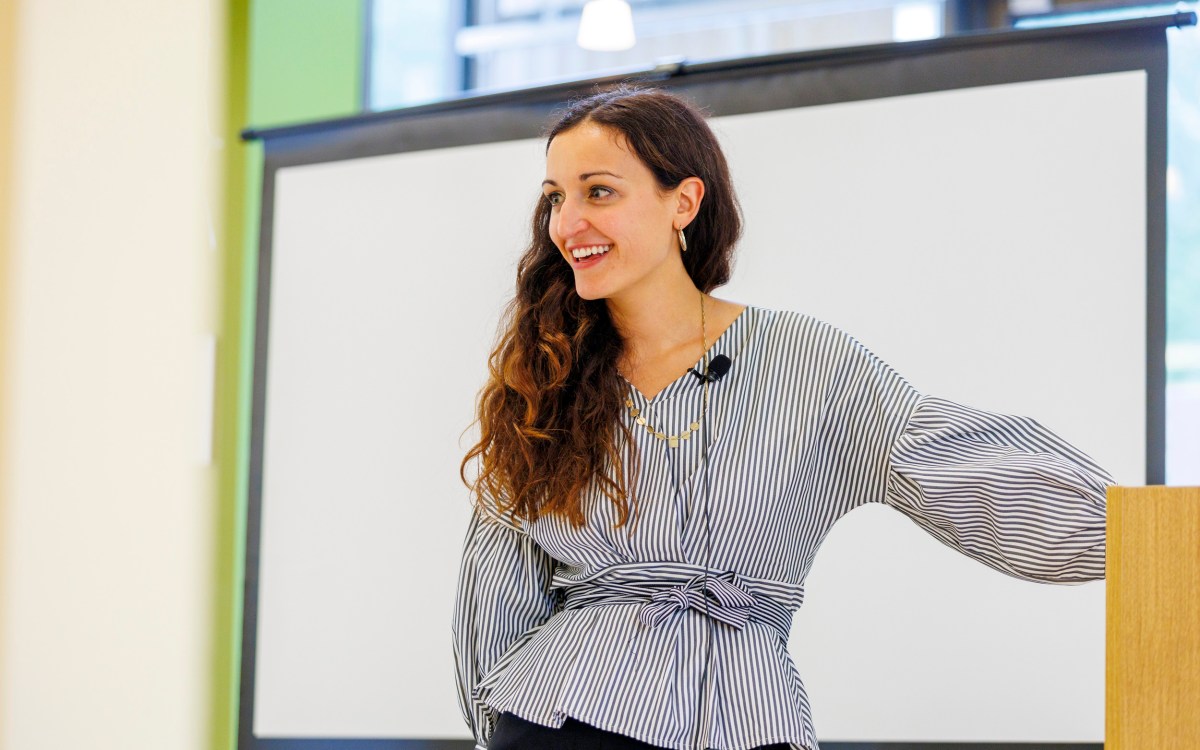‘Could I really cut it?’
Justice Ketanji Brown Jackson discusses new memoir, ‘unlikely path’ from South Florida to Harvard to nation’s highest court

Supreme Court Justice Ketanji Brown Jackson at Sanders Theatre last week.
Photos by Niles Singer/Harvard Staff Photographer
Ketanji Brown Jackson was plagued by homesickness and imposter syndrome as a College first-year in the late 1980s.
“Could I really cut it?” the Supreme Court Justice recalled thinking during a sold-out event at Sanders Theatre last Thursday marking the publication this month of “Lovely One,” which traces her “unlikely journey” from South Florida to the nation’s highest court.
That self-doubt began to evaporate with the help of an experience she had in that very venue: Taking Michael J. Sandel’s near legendary offering on classical theories of ethics and justice applied to issues of the moment. Sandel, the Anne T. and Robert M. Bass Professor of Government, has taught a version of the course for more than four decades.
“Doing well in that class was one of the things that helped me to see that maybe I could cut it here,” said Jackson ’92, J.D. ’96. “I loved that class, and it really confirmed for me that law and philosophy were things I was interested in.”

Harvard University
At the book talk, Jackson read a short excerpt and discussed her motivations in writing it with Tomiko Brown-Nagin, the event moderator and Harvard Radcliffe Institute Dean. “The key takeaway,” Jackson said, “is the good fortune of the moment of my birth. … I was born in 1970, five or six years after the Civil Rights Act and Voting Rights Act and the end of Jim Crow segregation.”
Jackson, 54, set to work on the book soon after her contentious confirmation hearings in March 2022. “I was really, really grateful to get through that experience successfully,” she said. “I felt as though I wanted to take the time to pay tribute to the people and circumstances that were most responsible for that accomplishment.”
At the top of the list are her parents, Ellery and Johnny Brown, both first-generation college graduates who grew up in segregated Florida. Jackson credited her mother, a middle-school educator, with teaching her to read at an early age. Her father, a high-school history teacher who enrolled at University of Miami Law School when Jackson was 3, inspired her interest in pursuing a legal career.
The Browns showered their daughter, a star student, with emotional support and enrichments. “My parents were very intentional about wanting me to participate and do all the things they didn’t get to do,” said Jackson, who listed swimming lessons and theater among her many extracurriculars.
In fact, it was the Miami Palmetto Senior High School speech and debate team that put Harvard on her radar. Jackson remembered raising money — “we sold a lot of candy” — to fund a trip to the annual national tournament on the University’s campus. “It was only because of that that I thought, ‘Oh, this looks like a pretty decent school,’” Jackson said to peals of laughter.
“I’m the first Black woman to get appointed to the Supreme Court. But I’m not the first Black woman who could do this job.”
An audience of about 1,000 people responded warmly throughout the hourlong event, hosted by the Hutchins Center for African & African American Research. Attendees included the justice’s Boston-based in-laws as well as at least one former roommate from her time living in Cabot House. Seated near the center of the theater was her husband of 28 years, Patrick G. Jackson ’91, a surgeon at MedStar Georgetown University Hospital.
The mood turned giddy as Jackson shared the story of their romance. She remembered Patrick, who counts among his ancestors King Edward I of England and four Mayflower passengers, sitting behind her in a history class. They became the sort of friends who awkwardly flirt. “Over time, I started to like him, but I felt like he probably didn’t like me,” Jackson said. “I had not had a serious boyfriend.”
The justice pantomimed the moment Patrick finally made his move — with a yawn and a stretch of the arm as they watched a Blockbuster movie rental at his parents’ place.
She recalled jumping to her feet. “I just don’t want to be hurt,” she protested.
Patrick stood and took her hands. “Ketanji,” he told her, “I will never hurt you. I love you.”
Also discussed was less ebullient material from the new memoir, including the time a 7- or 8-year-old Jackson found a handwritten note from her maternal grandmother. “She didn’t have a lot of schooling,” Jackson said. “She grew up in Georgia in the ’20s and ’30s.”
Jackson’s mother was “crestfallen” to find her daughter amused by the note’s misspellings. “She said, ‘I thought we were raising you better than this,’” Jackson recalled. “The memory of that [moment] has replayed throughout my life when I think about all the advantages I have been blessed to receive and how there are people who don’t have similar opportunities.”
Another formative chapter occurred during Jackson’s junior year at Harvard College, when a Confederate flag was displayed by a fellow Cabot House resident. Jackson participated in protests with the Black Students Association, as she recounts in the book. But what she focused on Thursday was the way racism functions as a distraction.
“What we needed to do was make sure we were still going to class, we were still doing our work, we were still doing well,” said Jackson, who credited this wisdom to a famous quote by the late “Beloved” author and Nobel laureate Toni Morrison.
Jackson briefly touched on “the mixed bag” of her parenting journey, in particular the challenge of reconciling her parents’ hard-driving “you got this, kid” model with the needs of her eldest daughter, who is on the autism spectrum. “I try to be as transparent as I can in the book about that,” she said.
Brown-Nagin, who also serves as the Daniel P.S. Paul Professor of Constitutional Law at Harvard Law School and a professor of history in the Faculty of Arts Sciences, asked about key mentors and role models. Jackson gushed about her experience clerking for retired U.S. District Judge for the Massachusetts District Patti B. Saris ’73, J.D. ’76. “She was my first real professional mentor, and we’re still very good friends,” Jackson said.
She was equally effusive about the late Constance Baker Motley, the first Black woman to serve as a U.S. federal judge and the subject of Brown-Nagin’s “Civil Rights Queen” (2023). Jackson learned of Motley while in middle school. It turns out, the trailblazing judges share a birthday, born on the same date 49 years apart.
Motley had been an “unbelievable” litigator, Jackson explained, winning nine of 10 cases argued at the Supreme Court before her appointment in 1966 to a U.S. District Court in New York. But ascending to the country’s highest bench simply wasn’t a possibility back then.
“I’m the first Black woman to get appointed to the Supreme Court,” Jackson said near the end of the event. “But I’m not the first Black woman who could do this job.”
Get the best of the Gazette delivered to your inbox
By subscribing to this newsletter you’re agreeing to our privacy policy




